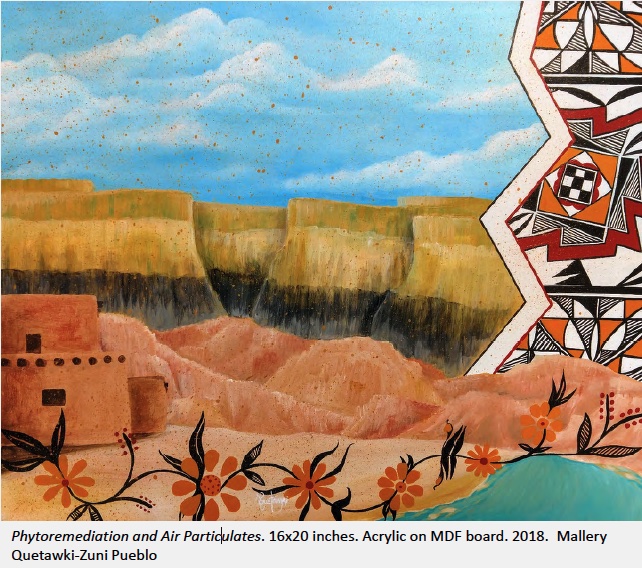METALS aims to understand how environmental metals contaminate water, air, and soil, and how these contaminants affect the health and wellbeing of communities living near AUMs.
These projects work to find and employ organic solutions to mitigate the effect of metals on impacted communities and develop remediation approaches responsive to community needs. Current work investigates how natural minerals and bioreactors containing fungi and plants can immobilize metals.

Adrian Brearley, PhD
Eliane El Hayek, PhD
Jose Cerrato, PhD
Joseph Galewsky, PhD
Many Native American communities in the Southwest US live in close proximity to numerous abandoned uranium mines (AUMs) that were active in the 1950s through 1980s. These communities are revitalizing agricultural activities on lands adjacent to abandoned mine sites that may have been contaminated by windblown dust during active and post mining activities. Two significant concerns of these tribal communities are: i) potential exposure to windblown, respirable (PM2.5), metals-bearing particulates; and ii) whether agricultural crops grown on tribal lands adjacent to AUMs could represent a potential exposure pathway that is detrimental to human health. Legacy uranium (U) mine sites in semi-arid regions are subject to strong aeolian (wind-related) processes, which influence the dispersion of U-bearing mineral dust, causing concern for human exposures to toxic dust that has potential negative health impacts. Understanding the bioavailability and bioaccessibility of U and co-occurring toxic metals in PM2.5, especially nanoparticulates in arising fugitive mineral dusts from legacy mine sites is important to identify health risks to affected communities.
The ESE PM project focus on the environmental risks of nanoparticle exposure stems from our preliminary results which show that previously unrecognized U-bearing nanoparticles are present in a range of different natural materials related to AUMs. Our research strategy will develop an understanding of: a) the origin, abundance, and physicochemical characteristics of nanoparticulate forms of U and co-occurring metals in mine wastes, soils, and windblown dust on tribal lands; b) their transport and redistribution due to windblown suspension presenting inhalation exposures, as well as contamination of agricultural lands and crops; 3) the relationship between the metals content of agricultural soil and uptake into agricultural crops that are a potential ingestion exposure pathway; and 4) the uptake mechanisms of these toxic metals into agricultural crops via root and foliar systems.
This project will provide data to address the concerns of tribal communities regarding potential exposure pathways from suspended PM (particulate matter) arising from legacy mine sites. Our findings will test the hypothesis that windblown transport of PM2.5 originating from AUMs represents a unique exposure-risk scenario to humans through inhalation and ingestion, based on the complex physicochemical characteristics of metal mixtures contained in the PM. Our results will establish the extent to which the complex metal mixtures in airborne PM released from AUM sites pose a health hazard and will more accurately address risk reduction strategies for these vulnerable populations who live in proximity to AUMs. This information will help to mitigate human exposures to metals mixtures resulting from the inhalation of windblown dust and the consumption of crops on agricultural lands that may have been contaminated by fugitive dust from mine sites both during their active phase of mining and in the present day.
Anjali Mulchandani, PhD
Jennifer Rudgers, PhD
Eliane El Hayek, PhD
Jose Cerrato, PhD
Previous studies of the UNM METALS Superfund Research Center report the co-occurrence of mixtures of uranium (U), arsenic (As), and vanadium (V) in waters and soils in sites affected by mining legacies in our partner communities in the Pueblo of Laguna and Navajo Nation. The burden of mining activities has affected various Superfund sites in the U.S., causing multigenerational metal exposures in our partner communities. Various sites affected by mining legacy in the US have not been adequately reclaimed or remediated.
The proposed research will contribute novel mechanistic insights that will enable the development of bioreactors catalyzed by plant-fungal symbiosis coupled with absorption and precipitation using natural minerals for sustainable bioremediation of metal mixtures. Calcium-minerals are naturally abundant in our partner communities, and we intend to further evaluate how these minerals react with phosphate to immobilize uranium and arsenic. We will also use fungi isolates obtained from sites located in our partner communities to identify relevant temperature stress gradients, water chemistry, and other environmental conditions in the Southwestern US influencing the uptake of metal mixtures by plant-fungal symbiosis. We will engineer bioreactors to identify environmental conditions that best promote metal uptake, mineral adsorption, and chemical precipitation by plant-associated fungi, informing predictions on bioremediation potential induced by future climate change.
This project will develop novel technologies for bioremediation by harnessing plant-fungal symbioses to immobilize metal mixtures through mineral absorption and precipitation. The co-occurrence of mixtures of uranium (U), arsenic (As), and vanadium (V) has been reported in waters and soils in natural geologic deposits and Superfund sites affected by mining legacies. However, few studies examine the reactivity of metal mixtures in environmentally relevant conditions. The integration of physicochemical and biological processes provides invaluable opportunities to gain new insights essential to risk assessment and to the advancement of novel bioremediation technologies.